Imbolc: Spring Awakens in the Belly of the Earth
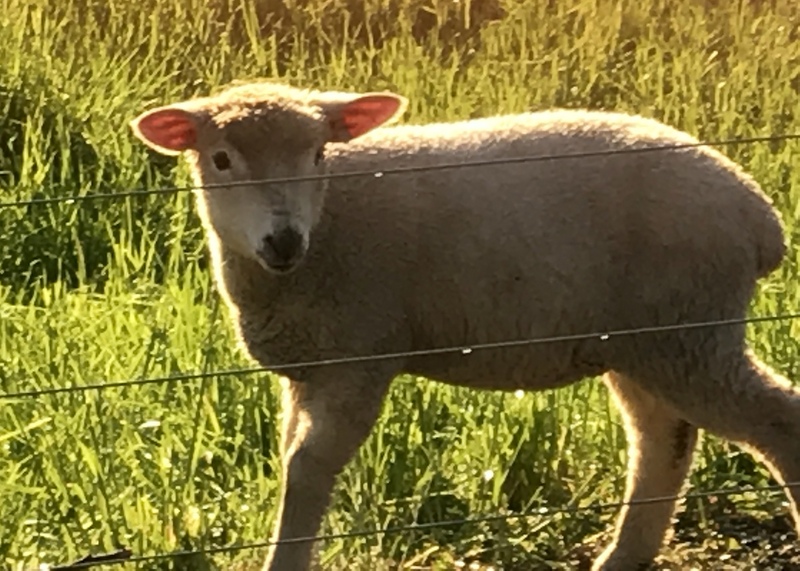
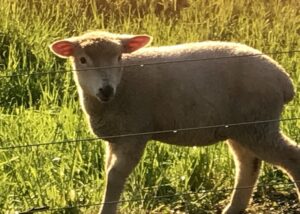
I watch the sun on the western horizon all year. Its setting spot barely moves near Solstices, but in February, the sun travels north over the oak and pine canopy in plain sight from my windows. Up close, oak, hickory, and birch leaves cover the forest floor, protecting hidden seeds waiting for warmer days. Tree roots push deep into the soil while sap rises in maple trees. Before long, the days warm, swelling seeds sprout, and a new cycle of life begins
My friend Marge invites me for a drive on a rare sunny day. We hope to see a flock of sheep. We drive on dirt country roads looking for signs of Imbolc, the Celtic name for the earth’s spring quickening. In the windswept field, cream colored sheep with shaggy coats nibble at hay piles provided by the farmer but they prefer the first grass shoots near a stream. Like us, they survived the darkness of winter and long for fresh green.

In the Celtic worlds of Ireland and Scotland, Imbolc or St. Brigid’s Day begins at sunrise on February 1, half way between Winter Solstice and Spring Equinox. It’s one of four cross-quarters half way between each solstice and equinox, each honored by pre-Christian Celts. Solstice and equinox mark the movement of the sun in the sky, but the Celtic cross-quarters such as May Day and Lammas (the time of grain harvest) mark Nature’s changing seasons here on earth.
When we see the herd of sheep, my heart fills with joy and hope.
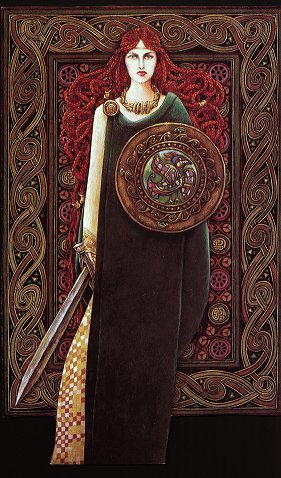
The Celtic pagan goddess Brigid became Saint Brigid after Romans established their religion in Britain between the Third and Sixth Century AD. The history is spotty, but I loved reading what is known in the link in the previous sentence. At Imbolc, the pagan rituals continued as Celts left gifts for Brigid–breads and ale, cloth and ribbons, and Brigid dolls and crosses made of rushes. They visited her sacred wells and collected water to bless their homes.
A huge community fire honored Brigid and celebrated the coming light and warmth. In return, she protected houses and livestock, especially sheep who give birth in spring and produce the first milk. She was celebrated with feasts and taught her devotees the arts of healing and prophecy, including a weather divination with echoes of Groundhog’s Day. In 2023, for the first time, Imbolc or St. Brigid’s Day is a public holiday in Ireland.
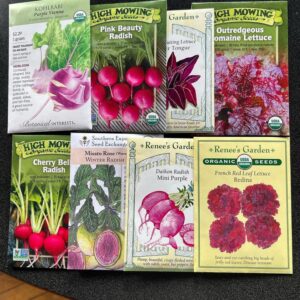 Imbolc means “in the belly,” the belly of the earth. Under the forest floor, seeds swell and quicken. In homes, it’s time for deep spring cleaning to remove winter’s death and prepare for new beginnings. It’s time to gather seeds and care for the vulnerable. Imbolc brings me back to a childhood joy of bottle feeding orphaned lambs in my grandpa’s flock.
Imbolc means “in the belly,” the belly of the earth. Under the forest floor, seeds swell and quicken. In homes, it’s time for deep spring cleaning to remove winter’s death and prepare for new beginnings. It’s time to gather seeds and care for the vulnerable. Imbolc brings me back to a childhood joy of bottle feeding orphaned lambs in my grandpa’s flock.
The light returns, lambs are born, and another cycle of life begins. In a few weeks, Marge and I will check the pregnant bellies in the herd and celebrate this time of promise and hope for those of us in northern lands.
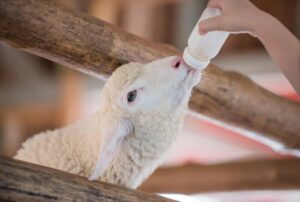
***
Do you see signs of a changing season in your world? For some, the days are growing shorter and in Western NY, days are growing longer. It’s still winter cold here, but the sun keeps moving north over the forest and the days will warm. What’s the weather report in your world? For other posts about the seasons of my world see Welcoming the Dark Time. Since it’s still cold, I’m also glad to think of the goddess Hestia in Home with Hestia, Goddess of the Hearth. My friend Marge is an example of a woman who knows how to tend the hearth.

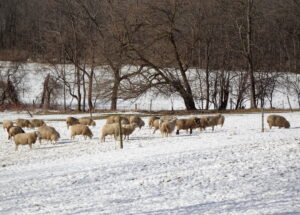


February 19, 2023 at 3:27 pm
Anne
Realize I never responded to your lovely entry on Imbolc, Elaine. Definitely a time of hope and promise. The first robins of the year showed up here on February 11, a bit earlier than usual. Since we’ve been keeping track, their earliest return was on January 30th (2015)just before Imbolc.
For years our neighbors kept goats, and we were always invited to help with the birthing — and then later with the bottle feeding as they were being weaned. I have never laughed so hard in my life at the level of Joy and hysteria involved in feeding bottles to a bunch of baby goats.
Sending blessings and wishes for warmth your way,
Anne
February 20, 2023 at 10:11 am
Elaine Mansfield
Anne, I saw a flock of robins during a period of warm weather, but they all returned to the forest this week. They’re around, but there’s no snow and the ground didn’t freeze this winter, so they’re dining elsewhere. They’ll be back.
Feeding baby lambs and goats is so much fun. They’re pure enthusiasm and so, so strong. They want life! Spring makes us all want life. (It’s been warm here, but freezing rain expected tomorrow. The weather is in a state of confusion which is what we expected from climate change, but expecting it and experiencing it are too different things.) Sending you spring blessings.
February 2, 2023 at 9:14 am
Jean Raffa
What can I say? I live in Florida! The seasonal changes are not so obvious here. When I look out the second-floor windows over my computer screen that overlook the cypress swamp on the other side of the creek, I see a canopy of gray and brown in the tall bald cypress trees. If there are any green buds peeking out among those long-fingered branches, I can’t see them from here. But there’s plenty of green in the lower trees and bushes. Most of the grass around here is green with patches of brown from lack of rain and a recent cold snap that reached 32 F. A rarity here.
Only the Christmas cactus on my back porch is celebrating the season with a riot of pink blossoms. As I’ve been writing this I’ve seen two large hawks, an osprey and a red-tailed hawk, fly by. A flock of grackles discovered our bird feeder the other day and emptied it before dark. The squirrels scratch through the earth beneath it and the cardinals, dark-eyed juncos, and tufted titmouse (mice?) keep stopping by hoping to find an overlooked seed or two.
I don’t know anyone who celebrates Imbolc here. I can see the days getting longer, but otherwise I feel deprived. I depend on your beautiful posts to keep me abreast of the seasonal changes that are more noticeable elsewhere. This one is especially rich. Thank you. Love, Jeanie
February 2, 2023 at 11:26 am
Elaine Mansfield
The only people I know who celebrate Imbolc are women in my mythology group and Deborah and Lin Gregory in England. It’s also the time of Groundhog’s Day or Candlemas in the Christian Church. Imbolc or St. Brigid’s Day is a decidedly northern holiday and a national holiday in Ireland as of this year. So she’s still honored in Ireland, Scotland, Wales, and other areas in northern Europe (along with the Green Man). I love cross-quarters because we can see the changes happening on earth such as lengthening days and probably new crops and flowers in your area. I have lengthening days but winter is still blasting us here. I looked at the temperature in Dublin a few days ago when it was 18 degrees here and it was 51 there since they’re warmed by the Gulf Stream. So, the changes happen in different ways in different climates, but nature keeps cycling and I love imagining the goddesses always in motion creating new worlds. Brigid is considered a fertility goddess and the youngest of the triple goddess.
You don’t have these drastic changes of season, but smaller changes in FL and more in North Carolina. We’re in for an artic blast in a few days (don’t feel deprived!), so no baby lambs unless they’re born inside a lambing barn. Blessed Imbolc. Love, Elaine
February 1, 2023 at 12:30 pm
Lin Gregory
I love Imbolc, it always fills me with hope and the knowledge that the harshness of winter will soon draw to a close. Your description of nature at this time in your part of the world paints such a vivid picture in my mind and I must agree about the layout of your words and images – it all flows so beautifully.
Here I think we’re a bit ahead of you being in the south of England, I always imagine your neck of the woods to be more like Scotland climate wise…although my geography is often way out! On one of my regular walks I first spotted daffodils on the 8th January…which is very early even for us! But since then the first celandines have been seen on our nature reserve and today I saw a bank of Periwinkle (vinca major) in full flower about a month ahead of time. Periwinkle is a symbol of hope, faith in the future and protection so a good omen I think!
In the bird world the Great Tits are calling across the woods looking for a mate and today we had a flock of Long Tail Tits invading a Ceanothus in our garden that had sadly met its demise in the drought of the summer. Add to that the heavily pregnant flocks of sheep, woodpeckers drumming and the two Tawny Owls in the trees behind our garden flirting with each other every night, I would say that the earths energy in this part of the world is definitely stirring!
February 1, 2023 at 1:49 pm
Elaine Mansfield
Hi Lin. I read yesterday that it was 51 degrees F in Dublin (not where you live, I know) and it was 19 F here. The Gulf Stream warms your part of the world. Outside my windows, I see a few inches of snow today and the wind is fierce. We’ll have a polar blast in the next few days. Sigh… I think I’m much colder than Scotland, but I’m not sure. There won’t be flowers here for another month. I heard a few birds on the one warmer day when my friend and I visited the sheep herd, but I haven’t heard them since. I love knowing spring is arriving in your world and it won’t be long until it arrives in mine. After the cold blast, the weather forecast says the temperatures will warm and melt the snow and ice–and meanwhile the days are noticeably longer which brings a sense of hope. Please let me know when your new website is up so I can explore. I’m excited this is happening and send you warmth, color, and love.
February 2, 2023 at 12:53 pm
Lin Gregory
We have to hang onto the knowledge that spring is round the corner…yet a polar blast gives another excuse to stay in the warm and germinate new ideas. Yes, my website was released yesterday at http://www.lingregory.com, I’ve added a blog page as well. I have much more work to do as there are still many new galleries to add but Imbolc felt the right time to release it into the world…thank you for your kind words and thoughts.
February 2, 2023 at 1:27 pm
Elaine Mansfield
I already visited your new website with those gorgeous mossy trees and sunlight coming through the forest. My kind of photos! I’ll keep watching because I subscribed, too. There’s always more work to do, but you have a beautiful start.
February 1, 2023 at 8:51 am
susan scott
I also watch the changing of the setting (as in landscape) of the rising and setting of the sun. Shadows lengthening, the afternoon sun sometimes blinding me if I’m driving. A slight change in daily and nightly temperatures. It remains warm during the day, in fact February can get seriously hot and humid.
Thank you for your lovely post Elaine and your detail of Imbolc. So necessary to honour the earth goddesses. Your photographs are lovely. Lovely to look forward to Spring! We’ll be looking forward to Autumn. Love, Susan
February 1, 2023 at 10:31 am
Elaine Mansfield
It’s autumn for you, Susan, and I remembered that as I wrote this piece. Ireland and Scotland, the lands of St. Brigid, are warmer than western New York because of the Gulf Stream. I just looked up the temperature in Dublin, Ireland at this moment (magic of the internet) and it’s 51 degrees F there and 18 degrees here. It will be super cold with intense winds on Friday here, but I’m used to a wrestling match between winter and spring here. This cold blast will only last a day and then the temperatures will have a hint of spring. May we receive the blessings of Brigid wherever we are. Sending you love.
February 1, 2023 at 6:28 am
Lori McCray
Anticipation! I love looking for signs. Lovely writing, as always. Love to you both, always!
February 1, 2023 at 10:16 am
Elaine Mansfield
Thank you, Lori. I imagine the swans know where the first grasses grow in shallow water. It’s a little warmer where you are (usually), so you may feel the change of the season sooner than I experience it. I looked around for signs in the forest yesterday and the moss is green and abundant at the base of oak trees. We’ll have a few frigid days here, but then warmer weather. I’m impatient for green and the first flowers. Love to you and yours.
February 1, 2023 at 6:26 am
Aladin Fazel
So wonderful! I love Celtic and Scottish Saga. It is amazing to know this beautiful Celtic Pagan Goddess and even as a Saint. I hope you had a lovely day with your friend, Marge, and thank you for letting me know this exciting story. You brought me a whiff of Spring in my mind; thank you!
February 1, 2023 at 10:10 am
Elaine Mansfield
Our women’s mythology class has celebrated the Celtic cross-quarters including Imbolc for many years, but I feel more connected to this Goddess and the awakening of spring after visiting the sheep. Like me, my friend Marge enjoys country life and she had visited them before. I also enjoyed the sweet memory of feeding bottles to the orphaned lambs in my grandfather’s herd when I was a young child. It’s cold here and will be Arctic cold beginning on Friday, so it’s good to imagine and remember the quickening of the seeds and the changing of the light. Blessed Imbolc!
January 31, 2023 at 9:33 am
Deborah Gregory
Dear Elaine, I do love the way you’ve laid this article out! It looks like a beautiful patchwork quilt made up of colour, words and images. And thank you for weaving so much wisdom, insights and Celtic mythology into this wonderful, rich post. I agree, Imbolc is a special time of the year, here at the end of winter and January’s liminality, as something new wants to kick in.
Here in the south of England, temperatures are slowly rising and the length of the day, too. Sunset is happening around 5pm, though its light enough to be outside now for another 30 minutes plus the night skies are incredibly clear now when there’s no clouds. The urge to take a literal a broom to my house, above and below, has arrived for that much needed spring clean.
Every time I’m out walking, I look everywhere for small signs of Imbolc too, though I haven’t seen any seen any new lambs yet, not long though. Snowdrops and early daffodils proliferate my neighbours garden (not ours sadly), however, we have lots of strong bluebell leaves poking through the softening soil. Wishing you a bright and beautiful Imbolc, love and light, Deborah.
January 31, 2023 at 11:26 am
Elaine Mansfield
Deborah, we live in a different climate and don’t have a warm Gulf Stream here to soften the sharp edge of winter. it will be -5 F (-20 Celsius) here on Friday night with a brisk wind. Ouch! That’s the coldest weather since Winter Solstice, but not unusual for February. I’ll be inside with a warm fire and hot tea. The front porch is loaded with dry firewood for the woodstove. We will be warm, but it’s hard to deal with this kind of cold late in the season, so I’ll complain along with everyone else who lives here. The sun sets after 5 and days are longe abd there are occasional warm days like the sunny day Marge and I visited the sheep. Even in the cold, the light is changing and I feel the power of Imbolc amd a seasonal change in the making. I love the stories and mythology of Brigid, but could only put a small amount in a blog so decided to focus on the lambs.
About spring cleaning: I asked the guys who loaded the firewood on the porch to help me move a dresser yesterday. This old house has a few small rooms I don’t need, and I’m slowly clearing them out. I’ve made lots of progress on this project this winter and have piles to donate. A little each day. We aren’t close to thinking of snowdrops and daffodils here. That’s usually March, but the light is changing and there will be more and more warm days. The grasses will grow for the sheep and cows and the pond ice will melt. Nature goes at her own pace, but when I see the first bluebird in February or March, I’ll know spring is here. Sending you warmth and longer days.